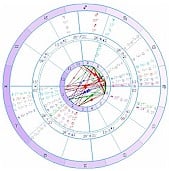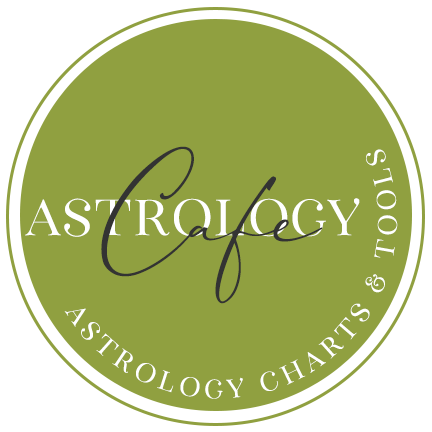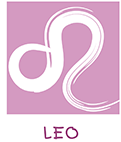Synastry Overview
Synastry & Relationship Astrology
Synastry is the art of relationship Astrology. It is a fascinating an illuminating study of how individuals interact with one another.
Each individual is born with a personal birth chart, which is a map of the heavens for the moment they took their first breath. Some might say the  birth chart has the effect of stamping, or imprinting, the energies of the planets and signs on an individual.
birth chart has the effect of stamping, or imprinting, the energies of the planets and signs on an individual.
Each and every one of us has all 10 planets and luminaries in our charts, but their positions by sign, house, and aspect are individual to each. When we interact with others, the individual energies of our natal charts form special relationships with their individual energies. The resulting interplay is as complex and unique as our own personalities.
Many of us are familiar with the study of Sun Sign Compatibility. Some will ask, for example, “Does a Leo get along with a Scorpio?” While these comparisons have some value, they are very general. Many other factors are involved when evaluating the compatibility of two people.
Although Synastry is complex, we can turn to some especially useful methods of studying relationships that will help shed light on our interactions. Below are some valuable pointers.
Major Considerations in Synastry
Venus is the Goddess of Love.Most of us are familiar with the significance of Venus in mythology. Venus, the goddess of love, provides us with valuable insights into how we approach matters of the heart. Venus rules romantic love, but it also plays a role in our pleasurable attachments in a more general sense. Many of us have experienced attractions to people that we don’t entirely understand. The art print at right is a sweet and humorous depiction of a girl who is trying to resist Cupid’s arrow. Why do we fall for people? Sometimes, our attractions make sense. Other times, our attractions seem entirely irrational. |
 |
|||||||
| Turning to Astrology, and more specifically, Synastry, will help us find answers. Venus rules attraction. Although other factors are involved, Venus is the planet of pleasure, romance, and union. Venus is particularly important in Synastry, and Venus interaspects are common with couples who enjoy a long-lasting and significant union.
Look to Venus in each person’s chart to see how each individual approaches, views, and handles love and relationship. Compare the natives’ Venus signs, noting the similarities and differences. (For Venus sign comparisons click here.) Then, determine if Venus makes an aspect to the other’s planets, luminaries, or angles (such as the Ascendant). When Venus in one chart aspects planets and points in another, the Venus person tends to get idealized and romanticized. The person with the contacted planet tends to expect a lot from Venus.
|
||||||||
Jupiter in SynastryWhen Jupiter in one person’s chart forms aspects with a personal planet or Ascendant in their partner’s chart, a special relationship is formed. The Jupiter person tends to give the other person the benefit of the doubt. Jupiter sees the good in the area of life and energy of the other’s contacted planet. Jupiter doesn’t tend to blind itself to the negative (that is Neptune’s job!). It simply searches for the positive, and finds much to like about the person. You can think of the Jupiter taking on the role of loving father who naturally finds goodness in his child. This is not the kind of father who refuses to see the “bad”, or who totally glorifies or idealizes his child. In fact, Jupiter is quite likely to see the negative, but he only wants to see his child grow, and easily excuses the less desirable traits, preferring to think that the good outweighs the bad. He is unthreatened by the child’s behavior. The Jupiter person in synastry wants to help out, cheer up, and encourage the other person. Jupiter gets the most pleasure when he sees his loved one grow. Therefore, if Jupiter contacts another person’s Moon, the Jupiter person will find the Moon person’s expression of his emotions, family values, and natural habits really quite wonderful and pleasing. Jupiter will encourage Moon to emote, to feel, and to seek security. Jupiter will have a strong need to protect the Moon person. When Jupiter contacts Venus, a pleasing attraction occurs between the two individuals. In the final Jupiter aspects in synastry are generally very helpful. While other difficult aspects may exist in synastry, overall goodwill between the individuals will outlast the conflicts. At the very least, even if these two end up parting, they will do so on good terms, remaining special friends. |
||||||||
|
|
||||||||
Mercury in SynastryMercury cross-aspects and interactions deserve some attention in any study of the dynamics of a relationship. See our article, Mercury in Synastry for more information. |
||||||||
|
|
||||||||
Mars is the God of WarMars, in relationship astrology, is the planet of sexual expression and desire. It shows us our animal instincts. While Venus rules romantic attraction, Mars indicates a more animal need for sex and assertion. It is important to note that Mars in synastry does not point to the need to be together forever. But, if other indicators of love and relationship are already present in synastry, strong Mars connections will help (or hinder) the relationship, mostly in the bedroom. When powerful interaspects of Mars occur, sex may not be as ecstatic and rich as those indicated by Venus, but it may be quite satisfying on a basic body level. When Mars figures strongly in synastry, but the aspects involved are quite difficult, the couple may find a lot to argue about. Even though Mars aspects may not bring together people in the first place, they have a lot of value. The conflict that they bring to a relationship can be difficult at times, but invigorating as well. If the individuals are growth-oriented, the basic truths that Mars interaspects bring will contribute to overall satisfaction. When Saturn is not involved, this couple will argue, and the growth that they pull from the conflict will likely spur them to have great sex together. Mars-Sun interaspects generally highlight action and physical attraction. The difficult aspects can indicate a passionate relationship that is filled with conflict. Mars-Moon interaspects can be very sexy and sometimes volatile. Emotionalism and domestic arguments can figure strongly in such a relationship when the difficult aspects are involved. Mars-Mercury interaspects, when flowing, indicate passionate and stimulating conversations. When difficult, regular discussions quickly turn into arguments. The Mars native may show insensitivity to the Mercury native’s point of view. Mars-Neptune aspects are generally indicative of sexual attraction, which can be disruptive and variable if the aspects are difficult. Mars-Pluto interaspects are similarly stimulating, though more intensely so. Difficult aspects can create battles of wills that threaten harmony. One of the most difficult aspects to occur between two charts is Mars-Saturn when it is in conjunction, square, or opposition. Unless the partners involved are prepared to work on the relationship with a sincere desire for growth, the tensions, frustrations, and blockages can feel insurmountable. Read more about the challenges of Mars-Saturn in synastry. Comparing the signs of each individual’s Mars can be illuminating. See our article, Mars in the Elements in Synastry for more information.
|
||||||||
|
|
||||||||
The Ascendant in SynastryThe Ascendant expresses our “body ego”—how we express ourselves through our body language and personal mannerisms. It also shows how we cope with the daily demands of life, our first reactions, and how we initiate
|
||||||||
|
|
||||||||
Aspects in SynastryIn Synastry, conjunctions between partners’ planets and points represent a point of powerful interaction. Depending on the planets involved, there can be a strong feeling of similarity and recognition. The opposition Sextiles and trines (generally considered “flowing” aspects) often suggest an ease at blending the two planets’ or points’ energies. There is often a warm and pleasant understanding and flow. These aspects do not necessarily generate attraction (as a conjunction might), but they are very supportive in a relationship. Trines generally Squares often point to energies that need work in order to integrate them easily into the interaction. While lack of understanding and frustration can be the result, they can also create just the right amount of tension to produce excitement in a relationship. Growth-oriented individuals will find that these “discordant” energies While it is helpful to consider any one interchart aspect carefully, it is also illuminating to consider the signs involved in the interaction. For example, squares between planets occupying mutable signs (Gemini, Virgo, Squares between cadent signs (Aries, Cancer, Libra, and Capricorn), conflicts are more likely to be stormy, direct, and overt—occasional big fights are typical. Between fixed signs (Taurus, Leo, Scorpio, and Aquarius), there can be frequent stand-offs. Of course, not all squares occur between planets in the same modality, but these examples serve as a general guideline.
|
||||||||
|
|
||||||||
The Sun in the Houses in Synastry: You Light Up My Life Where does your Sun fall in the natal chart of your partner? See our Sun in the Houses in Synastry article for more details. |
||||||||
|
|
||||||||
Saturn in SynastrySaturn interaspects can be viewed as some of the “glue” that binds people together, but they can be tricky to manage. Read more about Saturn in Synastry.
|
||||||||
More Relationship Astrology topics at CafeAstrology.com
Intermediate and advanced students of Astrology might enjoy our article, SoulMate Astrology.
Don’t know the positions of your planets? Be sure to find out your personal astrology positions online, at no cost. |
||||||||













